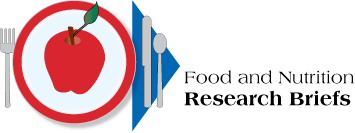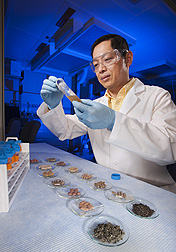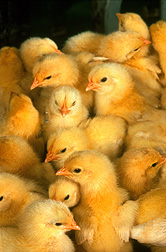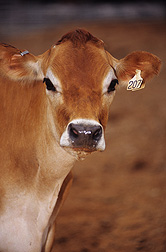| July 2012 |
Better Analysis Methods for Vitamin DAn Agricultural Research Service (ARS) scientist has pioneered new, highly precise methods using mass spectrometers for analyzing vitamin D and its metabolites in foods and dietary supplements. The researcher found ways in which multiple instruments that measure molecules can be used in parallel to provide much more information about food samples than single instruments used alone. One technique is "triple-parallel mass spectrometry," in which three mass spectrometers, operating in different modes, are used in parallel. The new spectrometry methods are also being used to discover compounds in foods that have never before been documented. Accurate data on the amount of vitamins and minerals in the U.S. food supply is critical to accurately assessing the intakes of these nutrients in the U.S. population. For details, contact: W. Craig Byrdwell, (301) 504-9357, ext. 230, Food Composition and Methods Development Laboratory, ARS Beltsville Agricultural Research Center, Beltsville, Md. |
|
|
|
Researchers Analyze Metabolites in BloodAn international collaboration that includes Agricultural Research Service (ARS) scientists has set out to document all of the metabolites in human blood. The ARS team's analyses focused on lipid metabolites involved in regulating biological processes. These metabolites are formed by the body from fats and oils in foods such as nuts, dairy products, meats and fish. The researchers are interested in determining how the kinds and concentrations of lipids in the body are influenced by eating habits, physical activity patterns, and genetic and environmental factors, and the relation of these lipids to obesity and its adverse effects on health. Their findings are available through the blood metabolites project's Serum Metabolome database at www.metabolomics.ca/. Though most of the metabolites documented in the database are not new to science, the database is nonetheless a significant resource. It is the first-ever public catalog of more than 4,000 metabolites in human serum, and represents the most comprehensive coverage of serum metabolites ever offered in one convenient, reliable source. For details, contact: John W. Newman, (530) 752-1009, ARS Western Human Nutrition Research Center, Davis, Calif. |
Analyzing Green Tea Leaves and SupplementsDifferences between phytochemicals in green tea dietary supplements and green tea leaves used for brewing beverages are being studied by Agricultural Research Service (ARS) scientists. Green tea-based dietary supplements have gained popularity in the U.S. market in recent years. But when it comes to sipping green tea versus taking the dietary supplement form, the better choice relative to health is unknown. Twenty extractions of commercially available green tea dietary supplement products and eight dry green tea leaf samples were analyzed. Chemical constituents of the samples were analyzed with a technique called "HPLC/MS" that can separate one chemical constituent from another in a complex matrix as well as accurately identify and quantify chemical constituents. The study demonstrated that phytonutrients called flavonol glycosides were degraded and that another phytonutrient called catechin had oxidized during manufacturing and storage for many of the green tea supplement samples studied. The researchers also found some additives in the supplements that were not listed on the labels. The researchers concluded that although there are fine green tea dietary supplement products, there is no way for the consumer to know the qualities of those products from reading the labels, and the quality of those green tea products varies significantly. For details, contact: Pei Chen, (301) 504-8144, ext. 238, Food Composition and Methods Development Laboratory, ARS Beltsville Agricultural Research Center, Beltsville, Md. |
|
|
|
"Kiddio" App May Help Parents Get Kids to Eat More VegetablesParents who are perplexed by their preschooler's dislike of vegetables may find help in a science-based video game that Agricultural Research Service (ARS)-funded scientists and their colleagues are creating for parents to play on smartphones. When complete, "Kiddio: Food Fight!" will give parents of preschoolers a fun, interactive way to learn some of the best approaches for getting their kids to eat more vegetables. The game will offer users a series of short, interactive episodes that feature "Kiddio," an appealing preschooler who doesn't like vegetables. Parents can customize the game so that Kiddio's temperament matches that of their child. The video game project draws on five studies that ARS-funded scientists have conducted over the past decade. These studies, involving thousands of parents, kids, and nutrition-related professionals, are examples of what has become known as "behavioral nutrition," a comparatively new scientific discipline that has roots in both psychology and nutrition. For details, contact: Tom Baranowski, (713) 798-6762, ARS Children's Nutrition Research Center, Houston, Texas |
Treating Poultry Diseases without AntibioticsIdentifying antimicrobial proteins in chickens that kill pathogens is one method being used by Agricultural Research Service (ARS) scientists to find alternatives to the use of antibiotics to control infectious poultry diseases. Each year, poultry diseases such as coccidiosis cause losses of more than $600 million in the United States and $3.2 billion worldwide. The ARS scientists have identified one such immune molecule, called NK lysin, and have demonstrated for the first time that this molecule kills chicken coccidia. The researchers also showed that this antimicrobial protein or host defense molecule is effective against other parasites such as Neospora and Cryptosporidia, which infect livestock and humans, respectively. One commercial company is looking at the possibility of developing NK lysin into a product that can be used to kill chicken intestinal parasites. For details, contact: Hyun Lillehoj, (301) 504-6170, Animal Parasitic Diseases Laboratory, ARS Beltsville Agricultural Research Center, Beltsville, Md. |
|
|
|
Organic Compounds Eliminate Disease-causing PathogensTwo natural compounds—chlorate and nitro—may offer an alternative to the use of certain antibiotics in the future to significantly reduce or eliminate disease-causing bacteria like Salmonella and E. coli in the gut of calves and piglets, thanks to a new method invented by Agricultural Research Service (ARS) researchers. Chlorate was found to have significant bacteria-killing activity against E. coli and Salmonella. However, chlorate has not been approved for commercial use in food animals by the U.S. Food and Drug Administration. When the nitro compound was added, the antimicrobial activity was enhanced 10- to 100-fold. Nitro compounds alone had significant bacteria-killing activity, which was more persistent than that of chlorate. But the nitro and chlorate compounds together were the best treatment. Salmonella alone causes more than 1.3 million cases of human foodborne disease each year, at a cost of $2.4 billion. For details, contact: Robin Anderson, (979) 260-9317, ARS Food and Feed Safety Research Unit, College Station, Texas |







